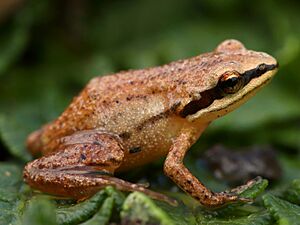Ngongoni moss frog facts for kids
Quick facts for kids Ngongoni moss frog |
|
|---|---|
 |
|
| Conservation status | |
| Scientific classification | |
| Synonyms | |
|
The Ngongoni moss frog (scientific name: Anhydrophryne ngongoniensis) is a tiny frog found only in South Africa. It's also known by other names like the Natal bandit frog or mistbelt chirping frog. This special frog belongs to the Pyxicephalidae family.
Ngongoni moss frogs live in cool mountain forests and sometimes in high grasslands. Sadly, their homes are disappearing fast. This is because of new tree plantations, the spread of invasive wattle trees, and uncontrolled fires.
Contents
Where the Ngongoni Moss Frog Lives
This tiny frog lives in a very small area in South Africa. You can find it on grassy slopes of hills that face the ocean. These hills are part of the eastern side of the Drakensberg Mountains. This area gets a lot of cool, moist air, so it often feels like it's in a permanent mist. The frog likes to hide deep inside clumps of grass.
What the Ngongoni Moss Frog Looks Like
This frog is quite small, only about 1.6 to 1.8 centimeters long. That's less than an inch! It has a sandy or golden-brown color. You can spot four broken stripes of darker brown running down its back and onto its legs. There's also a very clear fifth stripe that goes from its nose, through its eyes and ears, and stops just behind its eardrum.
How This Frog Was Discovered
The Ngongoni moss frog was found by chance by a scientist named P. Bishop. He was doing research on other frogs when he heard a strange call. He realized it was a new type of frog! The first frogs of this kind were found in a place called Ixopo in KwaZulu-Natal, South Africa. This frog is hard to spot because it blends in well with its surroundings. Scientists can tell it apart from other frogs mainly by its unique call.
Voice and Reproduction
The male Ngongoni moss frog makes a loud, shrill call that sounds like a cricket. During the day, when there isn't much light, it calls from inside grass clumps. At night, it might move to more open or higher spots to call.
How They Breed
What's really interesting about this frog is how it breeds. Unlike many frogs, it doesn't need standing water like a pond or puddle to lay its eggs. This is why its scientific name, Anhydrophryne, means "without water frog." The female frog lays about a dozen large, cloudy eggs. These eggs develop quickly, and in about 27 to 28 days, tiny, see-through froglets hatch. They are only about 0.4 centimeters long when they emerge!
Protecting the Ngongoni Moss Frog
Because this frog lives in such a small area, it is considered vulnerable. This means it could be in danger of disappearing. Its home is being lost very quickly. This happens because people plant new trees where the frogs live, and invasive wattle trees spread and take over their habitat. Wildfires and other uncontrolled fires also destroy the places where these special frogs live.


